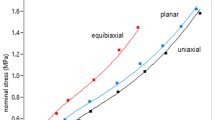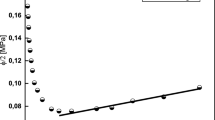Abstract
In this contribution, a new form of the strain energy function is proposed to describe the hyperelastic behavior of rubber-like materials under various deformation. The proposed function represents an invariant-based model and contains two material parameters. The model was tested with the experimental data of vulcanized rubbers, collagen and fibrin. The material parameters are kept constant for a material subjected to different types of loading. Good agreement between model and experimental data was obtained for all materials.






Similar content being viewed by others
References
Arruda, E., Boyce, M.: A three-dimensional constitutive model for the large stretch behavior of rubber elastic materials. J. Mech. Phys. Solids 41, 389 (1993). https://doi.org/10.1016/0022-5096(93)90013-6
Boyce, M.C., Arruda, E.M.: Constitutive models of rubber elasticity: a review. Rubber Chem. Technol. 73(3), 504–523 (2000)
Carroll, M.: A strain energy function for vulcanized rubbers. J. Elast. 103(2), 173–187 (2011)
Darijani, H., Naghdabadi, R.: Hyperelastic materials behavior modeling using consistent strain energy density functions. Acta Mech. 213(3–4), 235–254 (2010)
Dobrynin, A.V., Carrillo, J.M.Y.: Universality in nonlinear elasticity of biological and polymeric networks and gels. Macromolecules 44(1), 140–146 (2010)
Flory, P., Rehner, J.: Statistical mechanics of cross-linked polymer networks i. rubberlike elasticity. J. Chem. Phys. 11, 512 (1943). https://doi.org/10.1063/1.1723791
Fung, Y.: Elasticity of soft tissues in simple elongation. Am. J. Physiol. Leg. Content 213(6), 1532–1544 (1967)
Gent, A.: A new constitutive relation for rubber. Rubber Chem. Technol. 69, 59 (1996)
Holzapfel, G.A.: Nonlinear Solid Mechanics: A Continuum Approach for Engineering. Wiley, Hoboken (2005)
Isihara, A., Hashitsume, N., Tatibana, M.: Statistical theory of rubber-like elasticity. iv.(two-dimensional stretching). J. Chem. Phys. 19(12), 1508–1512 (1951)
James, H., Guth, E.: Theory of the elastic properties of rubbers. J. Chem. Phys. 11, 455 (1943)
Mansouri, M., Darijani, H.: Constitutive modeling of isotropic hyperelastic materials in an exponential framework using a self-contained approach. Int. J. Solids Struct. 51(25–26), 4316–4326 (2014)
Miehe, C., Göktepe, S., Lulei, F.: A micro–macro approach to rubber-like materials—part i: the non-affine micro-sphere model of rubber elasticity. J. Mech. Phys. Solids 52, 2617 (2004). https://doi.org/10.1016/j.jmps.2004.03.011
Ogden, R.: Non-Linear Elastic Deformations. Dover Publications, New York (1997)
Ogden, R.W.: Large deformation isotropic elasticity-on the correlation of theory and experiment for incompressible rubberlike solids. Proc. R. Soc. Lond. A Math. Phys. Sci. 326(1567), 565–584 (1972)
Sasso, M., Palmieri, G., Chiappini, G., Amodio, D.: Characterization of hyperelastic rubber-like materials by biaxial and uniaxial stretching tests based on optical methods. Polym. Test. 27(8), 995–1004 (2008)
Steinmann, P., Hossain, M., Possart, G.: Hyperelastic models for rubber-like materials: consistent tangent operators and suitability for treloar’s data. Arch. Appl. Mech. 82(9), 1183–1217 (2012)
Storm, C., Pastore, J.J., MacKintosh, F.C., Lubensky, T.C., Janmey, P.A.: Nonlinear elasticity in biological gels. Nature 435(7039), 191 (2005)
Treloar, L.: Stress-strain data for vulcanized rubber under various types of deformation. Rubber Chem. Technol. 17(4), 813–825 (1944)
Yeoh, O.H.: Characterization of elastic properties of carbon-black-filled rubber vulcanizates. Rubber Chem. Technol. 63(5), 792–805 (1990)
Acknowledgements
Author thanks the anonymous reviewers for their constructive and fruitful comments.
Author information
Authors and Affiliations
Corresponding author
Ethics declarations
Conflict of interest
The authors declare that they have no conflict of interest.
Additional information
Publisher's Note
Springer Nature remains neutral with regard to jurisdictional claims in published maps and institutional affiliations.
Rights and permissions
About this article
Cite this article
Külcü, İ.D. A hyperelastic constitutive model for rubber-like materials. Arch Appl Mech 90, 615–622 (2020). https://doi.org/10.1007/s00419-019-01629-7
Received:
Accepted:
Published:
Issue Date:
DOI: https://doi.org/10.1007/s00419-019-01629-7




